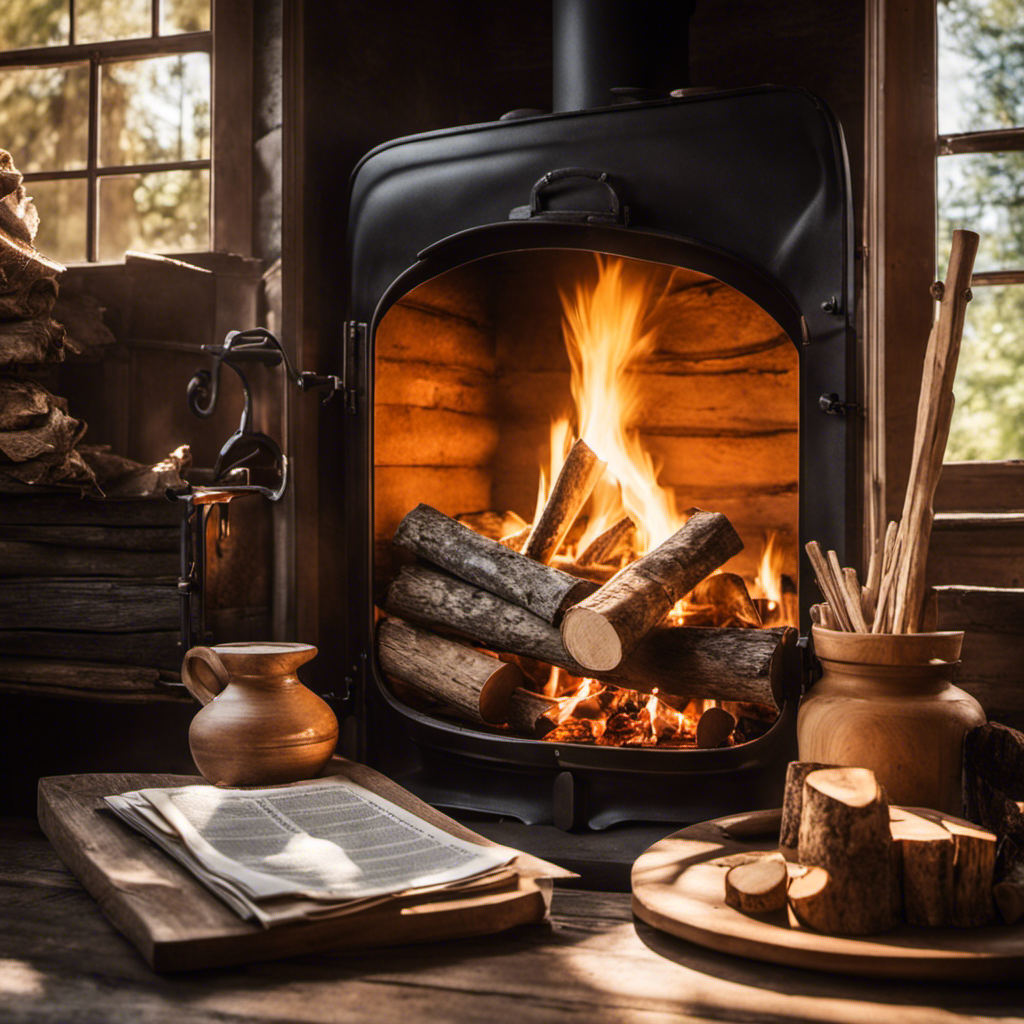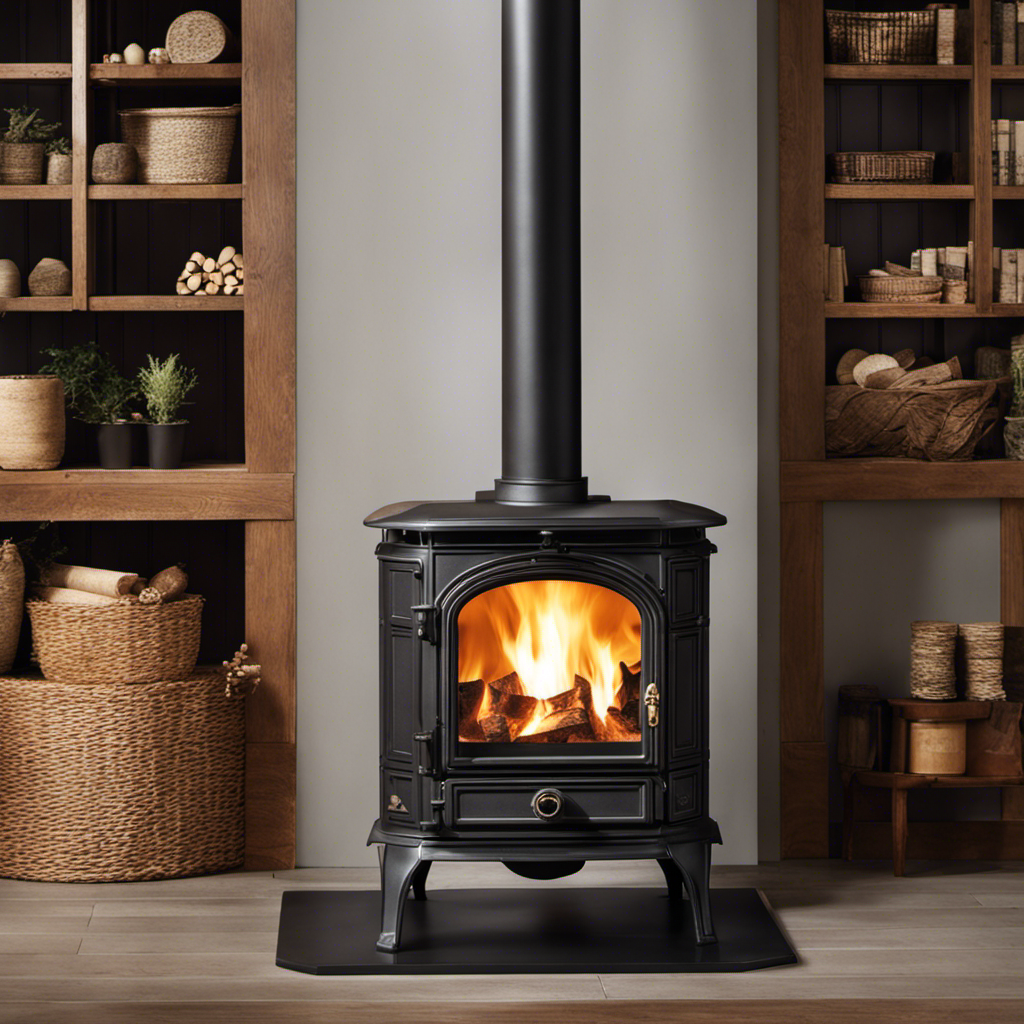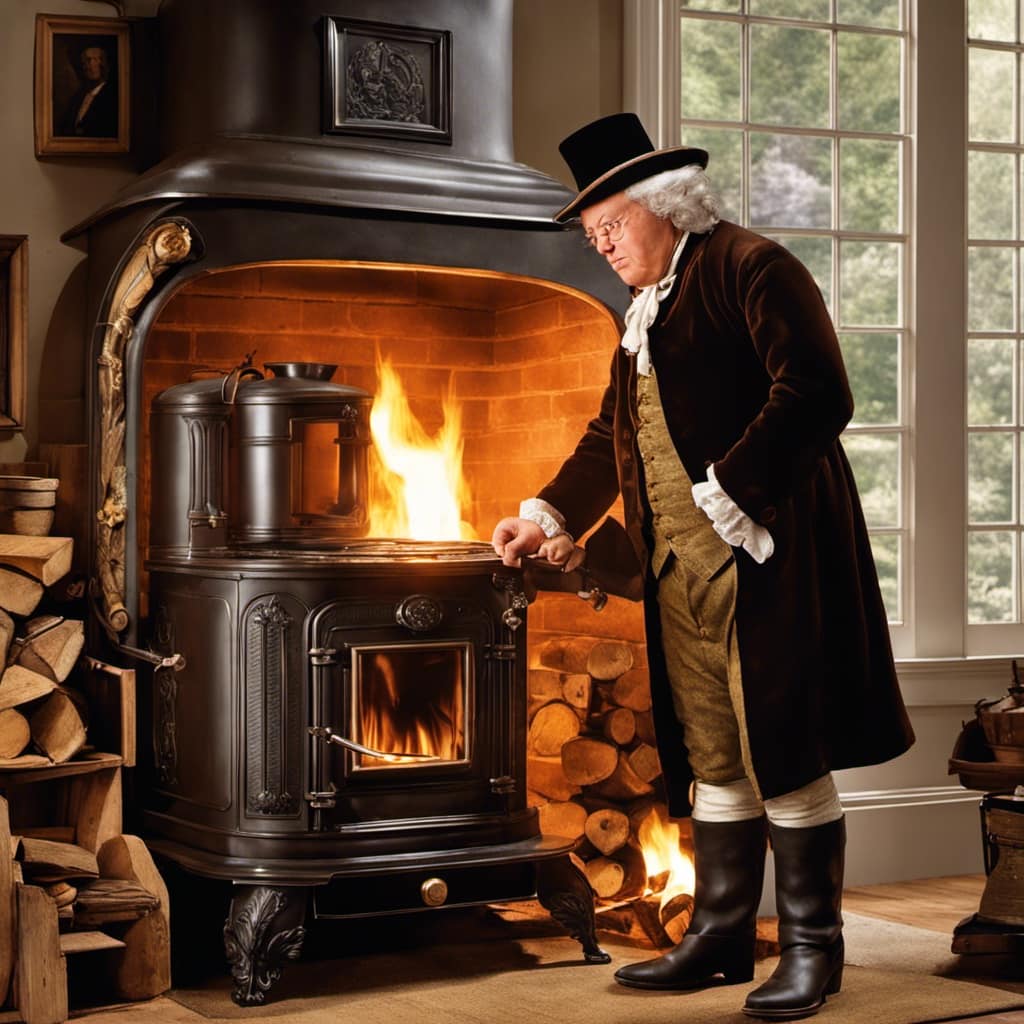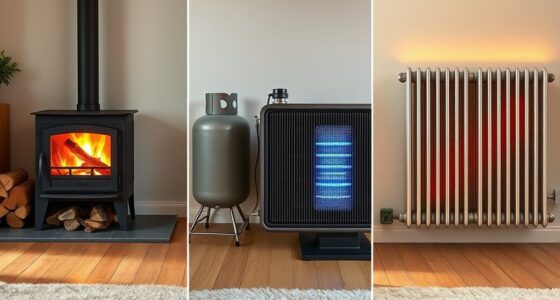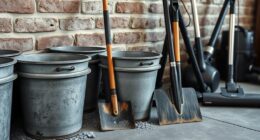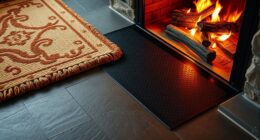Do you believe you have the skills to start a fire in a wood stove, huh? Well, my dear friend, it may not be as easy as you think. But do not worry, as I am here to help you through the process.
In this article, I will share with you the techniques, tips, and tricks to successfully ignite a cozy fire in your wood stove. Get ready to channel your inner firestarter and master the art of wood stove ignition.
Let’s get started!
Key Takeaways
- Select hardwoods like oak, maple, and birch for efficient burning.
- Use small, dry sticks or twigs as kindling to ignite larger pieces of wood.
- Regularly clean the chimney and flue to remove blockages.
- Properly stored firewood prevents moisture absorption and insect infestation.
Gather Your Firewood and Kindling
I’m going outside to gather some firewood and kindling for the fire.
When it comes to firewood storage, it’s important to select the right type of wood for efficient and effective burning. Hardwoods like oak, maple, and birch are ideal choices as they burn longer and produce more heat. Softwoods like pine can be used as kindling due to their quick ignition properties.
When selecting firewood, it’s crucial to ensure it’s properly seasoned and dry. Green or wet wood won’t burn efficiently and can create excessive smoke and creosote buildup in the chimney.
It’s also important to store firewood in a dry and well-ventilated area, off the ground, to prevent moisture absorption and insect infestation.
Taking these factors into consideration will ensure a successful fire and maximum heat output.
Prepare Your Wood Stove for Lighting
Before lighting the wood stove, I’ll make sure to thoroughly clean the ash pan and check the chimney for any obstructions. This step is crucial for the safe and efficient operation of the wood stove.
Here are some important points to consider when preparing your wood stove for lighting:
-
Cleaning and maintenance of your wood stove:
-
Regularly clean the ash pan to prevent ash buildup, which can hinder airflow.
-
Inspect the door gasket for any wear or damage, as a tight seal is essential for optimal performance.
-
Clean the glass window to maintain a clear view of the fire.
-
Choosing the right type of firewood for your wood stove:
-
Select seasoned hardwoods like oak or maple, as they burn longer and produce more heat.
-
Avoid using softwoods like pine or cedar, as they burn faster and create more creosote buildup in the chimney.
Use Proper Fire Starting Techniques
To ensure a successful fire in my wood stove, I’ll use both kindling and newspaper as proper fire starting techniques.
Fire safety is of utmost importance when lighting a fire, so it’s crucial to follow the correct fire building techniques.
First, I gather small, dry sticks or twigs as kindling. These will help ignite the larger pieces of wood.
Next, I crumple up sheets of newspaper and place them underneath the kindling. The newspaper acts as an excellent source of fuel to get the fire started.
It’s essential to ensure that the wood stove is properly ventilated and that there are no flammable items nearby.
Maintain Proper Airflow in Your Wood Stove
I ensure that I regularly clean the chimney and flue to maintain proper airflow in my wood stove. Airflow management is crucial for the efficient and safe operation of a wood stove. Here are some key points to consider when it comes to maintaining proper airflow:
- Clean the chimney and flue regularly to remove any blockages or buildup that can restrict airflow.
- Use a damper to control the amount of air entering the stove. Adjust it according to the desired heat output.
- Ensure that the air intake vents are clear and unobstructed to allow for proper ventilation.
- Consider installing a stove fan or blower to improve airflow and distribute heat more evenly throughout the room.
Importance of ventilation can’t be overstated when it comes to wood stoves. Proper airflow not only ensures efficient burning but also prevents the buildup of harmful gases like carbon monoxide.
Troubleshooting Tips for Difficult Fires
One common issue that can arise when lighting a fire in a wood stove is having too few logs and not enough kindling to get it started. This is a common mistake that can lead to difficulties in starting and maintaining a fire.
To avoid this problem, it’s important to ensure that you have an adequate supply of firewood and kindling before attempting to light a fire. Additionally, it’s essential to use dry and seasoned firewood, as damp or green wood can cause the fire to smolder and produce excessive smoke.
Another common firewood problem is using oversized logs that don’t fit properly in the wood stove. This can restrict airflow and make it difficult for the fire to burn efficiently.
To avoid this issue, always use properly sized logs that allow for proper airflow and combustion.
Frequently Asked Questions
How Long Should I Let the Firewood and Kindling Dry Before Using It in the Wood Stove?
I usually let the firewood and kindling dry for at least 6 months before using them in the wood stove. This ensures a moisture content of around 20%, which is optimal for efficient and clean burning.
Can I Use Paper or Cardboard as Kindling for Starting a Fire in the Wood Stove?
Sure, you can use paper or cardboard as kindling, but let’s not forget the safety precautions. Make sure they are dry and clean, and keep a fire extinguisher nearby, just in case. Stay safe, folks!
Should I Keep the Air Vents Fully Open While Lighting the Fire in the Wood Stove?
I keep the air vents fully open when lighting the fire in my wood stove. It helps provide an adequate oxygen supply for the flames to ignite and ensures a proper combustion process.
How Often Should I Clean the Chimney to Ensure Proper Airflow in the Wood Stove?
Cleaning the chimney is crucial to maintain optimal airflow in the wood stove. Neglecting it leads to decreased efficiency and potential hazards. Look out for signs of clogging, and regularly clean the chimney for safe and efficient operation.
What Should I Do if the Fire in My Wood Stove Is Not Producing Enough Heat?
If my wood stove isn’t producing enough heat, I can troubleshoot by checking the airflow, adjusting the damper, or using alternative fuels like seasoned hardwood or compressed sawdust logs.
Conclusion
In conclusion, lighting a fire in a wood stove requires proper preparation, technique, and airflow.
By gathering firewood and kindling, preparing the stove, and using effective fire starting techniques, you can ensure a successful fire.
Maintaining proper airflow is crucial for a well-lit fire.
Remember, troubleshooting tips can help with difficult fires.
So, go ahead and ignite your wood stove with the force of a thousand suns and enjoy the cozy warmth it brings!
Logan’s affair with adventure began in childhood. He hailed from a small town where vast forests bordered one side and endless shores stretched on the other. His days were spent exploring uncharted woods, climbing tall trees, or listening to the tales of old sailors. This early immersion in a world brimming with stories and mysteries became the foundation of his passion for writing.

